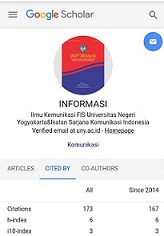Hyperreality study of hijab fashion celebrity
DOI:
https://doi.org/10.21831/informasi.v50i1.27842Keywords:
, hyper reality, representation, celebrity hijab, Instagram.Abstract
The purpose of this study is to look at the phenomenon of celebrity on social media Instagram and relate it to the hyper-reality theory by Jean Baudrillard. The vast expression space provided by online media has led to a wave of folk culture that allows anyone to become a producer and consumer of texts. Clothing recommendations are now much oriented on the celebrity fashion hijab. The problem is whether this celebrity hijab fashion is an accurate representation of Instagram users, so users often imitate the style of the role model. This study uses the theory of hyperreality, the concept of social media, and celebrity on Instagram. This study uses a post-positivist paradigm, qualitative, and quantitative approaches. The unit of analysis in this study is the followers of hijab fashion celebrity's Instagram. Data collection techniques are an in-depth interview and survey. The results showed the level of representation in Baudrillard's terminology"” which includes (1) representations that lie behind facts, (2) representations that cover facts, (3) representations that do not have facts, and (4) representations that are not related to facts"”and identification of reasons for joining certain celebrity fashion hijabs. The literacy point emphasizes on what is shown by "˜celebgram' is not the actual reality. It is just a representation that refers to "˜itself' and not for others. Impersonation can produce a range of satisfaction for disappointment.
Tujuan penelitian ini adalah melihat fenomena selebriti Instagram dan kaitannya dengan teori hyper-realita dari Jean Baudrillard. Ruang ekspresi yang terbuka luas akibat perkembangan media online, menyebabkan terjadinya gelombang budaya akar rumput yang memungkinkan siapa pun untuk menjadi produsen dan konsumen teks secara bersamaan. Hal inilah yang memungkinkan siapa pun untuk menjadi "˜ahli' di bidang yang mereka kerjakan atau sukai, dan fashion jilbab adalah salah satunya. Rekomendasi mode banyak berorientasi pada jilbab fesyen selebriti di Instagram. Masalahnya adalah apakah busana hijab yang dikenakan selebriti di Instagram ini merupakan representasi sebenarnya dari pengguna, sehingga pengguna sering meniru gaya para selebgram tersebut. Penelitian ini menggunakan teori hyperreality, konsep media sosial dan selebriti di Instagram. Penelitian ini menggunakan paradigma postpositivis, pendekatan kualitatif, dan kuantitatif. Unit analisis dalam penelitian ini adalah followers selebgram hijab fashion. Teknik pengumpulan data adalah wawancara mendalam dan survey. Hasil penelitian yang diperoleh adalah tingkatan representasi dalam terminology Baudrillard"”yang meliputi (1) representasi yang berada di balik fakta, (2) representasi yang menutupi fakta, (3) representasi yang tidak ada faktanya, serta (4) representasi yang tidak berhubungan dengan fakta"”dan identifikasi alasan para followers mengikuti gaya selebgram tertentu. Aspek literasi yang ditekankan dalam penelitian ini adalah pada apa yang ditunjukkan oleh "˜selebgram' sejatinya bukanlah realitas yang sebenarnya. Itu hanya representasi yang merujuk pada "˜dirinya sendiri' (selebgram) dan bukan untuk orang lain. Peniruan identitas dapat menghasilkanskepuasan atau justru kekecewaan.
References
Abidin, C. (2018). Internet Celebrity: Understanding Fame Online. European Journal of Communication, 33(6), 696–697. https://doi.org/10.1177/0267323118814646a.
Baudrillard, J. (1994). Simulacra and Simulation (The Body, In Theory: Histories of Cultural Materialism) (14th ed.). Michigan: University of Michigan Press.
Bennett, P., Kendall, A., & McDougall, J. (2011). After the media: Culture and identity in the 21st century. In After the Media: Culture and Identity in the 21st Century. https://doi.org/10.4324/9780203817889.
Bourdieu, P. (2007). Contemporary Sociological Theory. USA: Blackwell Publishing.
Castells, M. (2009). The Rise of the Network Society (2nd ed.). Sussex, United Kingdom: Wiley-Blackwell Publishing Ltd.
De Veirman, M., Cauberghe, V., & Hudders, L. (2017). Marketing through instagram influencers: The impact of number of followers and product divergence on brand attitude. International Journal of Advertising, 36(5), 798–828. https://doi.org/10.1080/02650487.2017.1348035
Driessens, O. (2013). Celebrity capital: Redefining celebrity using field theory. Theory and Society, 42(5), 543–560. https://doi.org/10.1007/s11186-013-9202-3.
Hakim, S. . (2016, April 15). Gaya Fashion BLogger di Industri Maju. Koran Tempo.
Harari, Y. N. (2017). Homo Deus: A Brief History of Tomorrow (1st ed.). New York: HarperCollins.
Hermanda, A., Sumarwan, U., & Tinaprillia, N. (2019). the Effect of Social Media Influencer on Brand Image, Self-Concept, and Purchase Intention. Journal of Consumer Sciences, 4(2), 76–89. https://doi.org/10.29244/jcs.4.2.76-89.
Jamil, R. A., & Hassan, S. R. ul. (2014). Influence of celebrity endorsement on consumer purchase intention for existing products: a comparative study. Journal of Management Info, 1(4), 1–8. https://doi.org/10.31580/jmi.v4i1.18.
Jarvis, J. (2011). What Would Google Do?: Reverse-Engineering the Fastest Growing Company in the History of the World. New York: Harper Business.
Jenkins, H. (2006). Convergence Culture: Where Old and New Media Collide. New York: NYU Press.
Karasiewicz, G., & Kowalczuk, M. (2015). Effect of Celebrity Endorsement in Advertising Activities by Product Type. International Journal of Management and Economics, 44(1), 74–91. https://doi.org/10.1515/ijme-2015-0010.
Labrecque, L. I., vor dem Esche, J., Mathwick, C., Novak, T. P., & Hofacker, C. F. (2013). Consumer power: Evolution in the digital age. Journal of Interactive Marketing, 27, 257–269. https://doi.org/10.1016/j.intmar.2013.09.002.
Loon, J. Van. (2007). Media Technology: Critical Perspectives: Critical Perspectives (Issues in Cultural and Media Studies. Berkshire, England: McGraw-Hill Open University Press.
Marwick, A. E. (2013). Status update: Celebrity, publicity, and branding in the social media age. In Status Update: Celebrity, Publicity, and Branding in the Social Media Age. https://doi.org/10.5860/choice.51-5062.
Matrix, S. E. (2006). Cyberpop: Digital lifestyles and commodity culture. In Cyberpop: Digital Lifestyles and Commodity Culture. https://doi.org/10.4324/9780203959855.
Natasya, N. (2018, May). Deretan Selebgram Hijab Indonesia Yang Paling Modis! Cosmopolitan Indonesia, 20–36.
Nugraha, R., Kusumawardani, K. A., & Octavianie, V. (2018). The Influence of Celebrity Endorsement in Instagram towards Customer Behavior and Purchase Intention in Healthy Food Diet Business. Firm Journal of Management Studies, 3(2), 1–24. https://doi.org/10.33021/firm.v3i2.476.
Pacey, A. (1983). The Culture of Technology. Cambridge Massachuset: MIT Press.
Safko, L., & Brake, D. K. (2009). The Social Media Bible: tactics, Tools, and Strategies for Business Success. Canada: John Wiley & Sons, Inc.
Schouten, A. P., Janssen, L., & Verspaget, M. (2019). Celebrity vs. Influencer endorsements in advertising: the role of identification, credibility, and Product-Endorser fit. International Journal of Advertising, 0(0), 1–24. https://doi.org/10.1080/02650487.2019.1634898.
Downloads
Published
How to Cite
Issue
Section
Citation Check
License
Authors who publish with this journal agree to the following terms:
- Authors retain copyright and grant the journal right of first publication with the work simultaneously licensed under a Creative Commons Attribution License that allows others to share the work with an acknowledgement of the work's authorship and initial publication in this journal.
- Authors are able to enter into separate, additional contractual arrangements for the non-exclusive distribution of the journal's published version of the work (e.g., post it to an institutional repository or publish it in a book), with an acknowledgement of its initial publication in this journal.
- Authors are permitted and encouraged to post their work online (e.g., in institutional repositories or on their website) prior to and during the submission process, as it can lead to productive exchanges, as well as earlier and greater citation of published work (See The Effect of Open Access).












